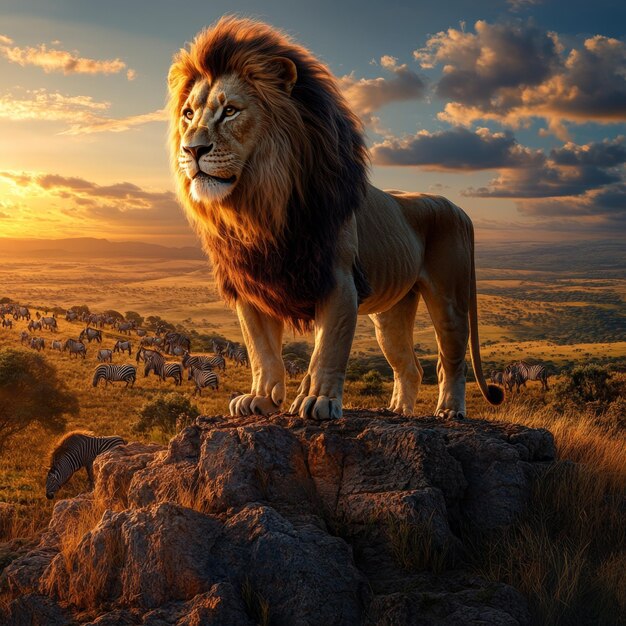The Majesty of Big Cats: Lions, Tigers, and More
The allure of big cats has captivated humanity for centuries. These magnificent creatures, from the regal lion to the elusive tiger, embody a blend of beauty, strength, and grace that few animals can rival. They roam the earth with an aura of power, dominating the landscapes they inhabit.
Understanding these majestic felines goes beyond mere admiration; it invites us to appreciate their roles in ecosystems, their cultural significance, and the urgent need for conservation.
The Majestic Lion: King of the Savanna
 Lions are often regarded as the epitome of strength and courage, earning their title as the "King of the Jungle" despite predominantly residing in savannas and grasslands. With their iconic manes and powerful roars, lions command respect in both nature and human culture.
Lions are often regarded as the epitome of strength and courage, earning their title as the "King of the Jungle" despite predominantly residing in savannas and grasslands. With their iconic manes and powerful roars, lions command respect in both nature and human culture.
Social Structure
Unlike most big cats, lions are social animals that live in prides. These groups consist of related females, their cubs, and a coalition of males. This unique social structure allows them to work together when hunting and protecting their territory.
Hunting Strategies
Lions are apex predators, known for their cooperative hunting techniques. Females typically do most of the hunting, relying on teamwork to bring down prey. Their preferred prey includes wildebeests, zebras, and buffalo, but they are also opportunistic hunters.
Cultural Significance
Throughout history, lions have symbolized bravery and nobility. They feature prominently in various cultures, mythology, and heraldry, representing power and leadership. Their imagery graces coats of arms, flags, and emblems worldwide.
The Striped Tiger: The Stealthy Hunter
Tigers, with their striking stripes and solitary nature, are among the most enigmatic of big cats. They are the largest of the felines and are revered for their strength, beauty, and adaptability to diverse habitats.
Habitat and Distribution
Tigers inhabit a range of environments, from tropical forests to grasslands and mangroves. The subspecies vary widely in their habitats, with the Bengal tiger primarily found in India and the Siberian tiger adapted to the colder climates of Russia.
Hunting and Behavior
Tigers are solitary hunters, relying on stealth and strength to catch their prey. They are primarily nocturnal, employing a strategy of ambush to surprise animals like deer, wild boar, and buffalo. Their unique stripes provide excellent camouflage in their natural habitats.
Conservation Challenges
Sadly, tigers are facing severe threats due to habitat loss, poaching, and human-wildlife conflict. Conservation efforts are critical to ensuring the survival of these magnificent creatures, with organizations working tirelessly to protect their habitats and reduce poaching.
The Elegance of Leopards: Masters of Adaptation
Leopards are the epitome of adaptability and resourcefulness. These big cats possess a remarkable ability to thrive in diverse environments, from rainforests to savannas, showcasing their versatility in hunting and survival.
Camouflage and Hunting Techniques
Known for their beautiful rosettes, leopards are experts in camouflage. They can blend seamlessly into their surroundings, allowing them to ambush prey effectively. They are also skilled climbers, often dragging their kills into trees to protect them from scavengers.
Diet and Behavior
Leopards have a varied diet, preying on a range of animals from rodents to antelopes. Their opportunistic feeding habits enable them to adapt to changing food availability, which is vital for survival in unpredictable environments.
Cultural Representation
Leopards have held cultural significance in many societies, often symbolizing stealth and cunning. They feature prominently in African folklore, art, and literature, embodying both beauty and danger.
Conservation: Protecting the Majesty of Big Cats
Despite their majesty, big cats face unprecedented challenges in the modern world. Habitat destruction, poaching, and climate change threaten their survival, making conservation efforts more crucial than ever.
Habitat Preservation
Protecting the natural habitats of big cats is essential for their survival. This includes establishing and maintaining wildlife reserves and national parks that provide safe spaces for these animals to roam and thrive.
Anti-Poaching Initiatives
Many organizations are actively working to combat poaching by implementing anti-poaching measures, educating local communities, and promoting sustainable livelihoods. Raising awareness about the importance of big cats in ecosystems is vital to garnering support for conservation efforts.
Community Involvement
Engaging local communities in conservation efforts is crucial for the success of protecting big cats. By providing economic incentives for wildlife conservation and involving communities in monitoring and protecting these species, we can foster a sense of stewardship that benefits both people and wildlife.
Global Collaboration: International cooperation is necessary to address the challenges facing big cats. Collaborative efforts among governments, NGOs, and local communities can help create comprehensive strategies that protect these majestic animals across their ranges.
Conclusion
The majesty of big cats transcends their physical beauty; it encompasses their ecological roles, cultural significance, and the urgent need for conservation. By understanding and appreciating these magnificent creatures, we can work together to ensure their survival for future generations. Protecting lions, tigers, leopards, and other big cats is not only about preserving nature but also about safeguarding the intricate web of life on our planet.
As we marvel at the grace and power of these incredible animals, let us also take action to protect their habitats and secure their futures. The fate of big cats lies in our hands, and it is our responsibility to ensure their majesty endures.
References
- National Geographic – Lions
- World Wildlife Fund (WWF) – Tiger Conservation
- International Union for Conservation of Nature (IUCN) – Leopard Conservation
- Wildlife Conservation Society – Big Cats Overview
- Smithsonian National Zoo – Tiger Facts
- African Wildlife Foundation – Lions and Their Ecosystems
- The Humane Society of the United States – The Big Cats
- Panthera – The Global Big Cat Conservation
- Conservation International – Importance of Big Cats
- National Geographic Society – Wildlife and Conservation












































